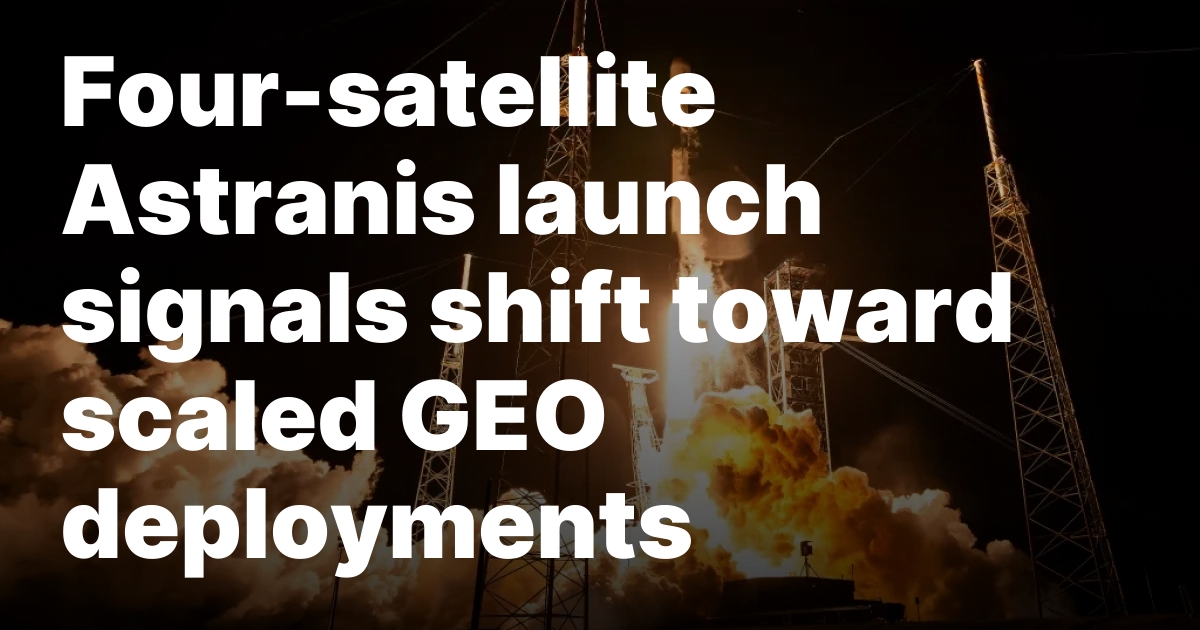SpaceX and Astranis Team Up for Historic Satellite Launch
In a significant milestone for space technology and communication, SpaceX successfully launched four satellites built by Astranis, a company based in San Francisco, on December 29th. This launch is noteworthy as it marks the first time a single commercial manufacturer has sent four of its own satellites into geostationary orbit (GEO) in a single mission.
At precisely midnight Eastern Time, a Falcon 9 rocket carrying these satellites took off from Cape Canaveral Space Force Station in Florida. Just a little over thirty minutes later, the satellites were placed into a super-synchronous geostationary transfer orbit, setting the stage for their journey to GEO.
The Journey and Technical Innovations
Three hours after the launch, Astranis spokesperson Christian Keil confirmed that they had successfully acquired signals from the satellites. These satellites are expected to take a few months to reach their designated positions in space. During this time, they will undergo numerous health checks to ensure they are ready for commercial operations.
This mission follows the launch of Astranis’s previous satellite, Arcturus, which was the first satellite based on their innovative MicroGEO platform. Weighing around 400 kilograms, this platform has the unique ability to be reprogrammed while in orbit. However, after its successful launch aboard a SpaceX Falcon Heavy in April 2023, Arcturus encountered a malfunction with two of its onboard solar array drive assemblies. This problem prevented the satellite from maintaining its solar arrays in the optimal position for consistent power, impacting its initial mission to provide broadband services to Alaska through Pacific Dataport.
In response to this setback, Astranis made significant improvements to its satellite design. The Block 2 batch of satellites incorporates several advancements, such as:
- A newly designed gimbal, expected to extend the operational life of the satellites from seven to at least eight years.
- A deployable main reflector, which is designed to increase the Ka-band throughput per satellite from 10 gigabits per second (Gbps) to 12 Gbps.
Adapting to Challenges
Despite the challenges with Arcturus, Astranis found a new role for the satellite by relocating it over Asia to support Spacecom, an Israeli operator. This move helped Spacecom maintain its claim to an orbital slot it had reserved in the region under international regulations.
Meanwhile, the four Block 2 satellites are poised to fulfill diverse roles. Two of them, named NuView Alpha and NuView Bravo, are destined for GEO over the Americas. They will provide inflight connectivity services for Anuvu, a company specializing in connectivity solutions for aviation and maritime sectors.
Another satellite in this batch, Agila, has been sold to Orbits Corp, a subsidiary of Philippine internet service provider HTechCorp. This satellite will be the first-ever communications satellite dedicated solely to serving the Philippines. The fourth satellite, UtilitySat, is designed as a multi-mission spacecraft to serve various customers throughout its lifespan. Initially planned to provide bridge capacity over Alaska, UtilitySat will first offer communication services over Mexico for Apco Networks, a Mexican telecommunications company. Apco has also ordered two of the five Block 3 Astranis satellites scheduled for launch next year.
Christian Keil explained, "This UtilitySat mission will be an accelerator to that mission — giving them capacity to get started and get some market traction before the two dedicated sats launch."
The Business Model and Future Plans
Astranis operates its satellites and sells their capacity under long-term lease agreements. Unlike the typical GEO satellites that are the size of a school bus, Astranis’s satellites are compact, about the size of a dishwasher, and are designed to cover smaller regional areas.
John Gedmark, CEO of Astranis, expressed confidence in the company’s ability to scale operations, stating, "With this launch, we will prove that Astranis can ship and operate multiple satellites at once. We are well on our way to the increased manufacturing cadence we need to hit to meet all of our customer demand, including both commercial and government."
Looking further ahead, Astranis plans to launch its next-generation Omega broadband spacecraft in 2026. These satellites will be slightly larger than their predecessors and are expected to offer five times more throughput, which could significantly enhance broadband services.
Industry Implications and Competitive Landscape
The December 29th mission signifies more than just a technical achievement for Astranis. It positions the company as the fourth entity to deploy four or more satellites to GEO in a single calendar year, joining the ranks of established players like SES, Intelsat, and Eutelsat.
Despite the declining interest in traditional GEO satellites, as low Earth orbit (LEO) constellations gain popularity, Astranis has managed to launch more satellites to GEO in the last two years than any other operator. This achievement underscores the potential for small GEO satellites in the communication sector.
Switzerland’s Swissto12 is another player eyeing the small GEO market. The company aims to deploy its first satellites in 2026, having secured four orders from Viasat and Intelsat. This competition highlights the growing interest in smaller, more agile satellite solutions capable of delivering focused regional services.
Conclusion
The successful launch of four Astranis-built satellites aboard a SpaceX Falcon 9 rocket marks a significant milestone in the evolution of satellite communications. By deploying multiple satellites in a single mission, Astranis demonstrates its capability to innovate and adapt in a competitive industry. With improvements in satellite technology and a clear vision for future growth, Astranis is poised to play a pivotal role in expanding global broadband access. As the demand for reliable and high-speed internet continues to grow, the contributions of companies like Astranis will be crucial in shaping the future of connectivity.
For more Information, Refer to this article.


































